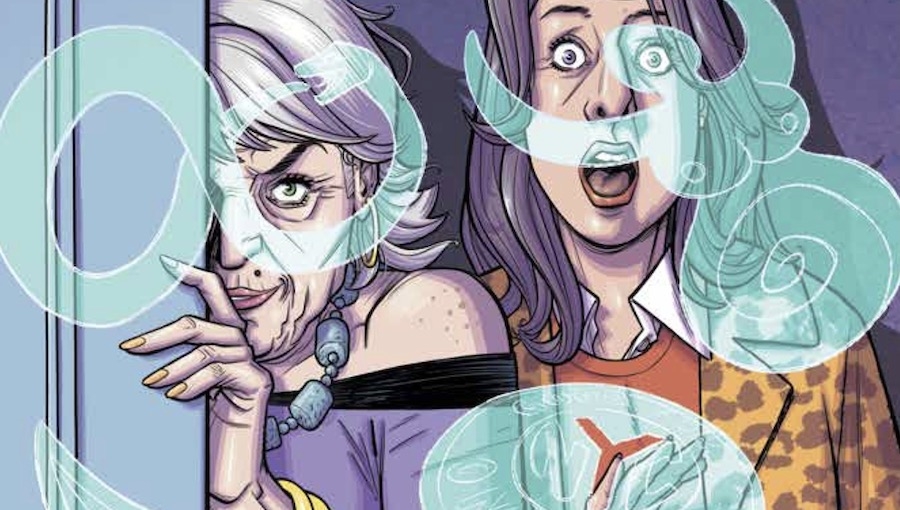The following is an interview with Eisner-nominated comics writer and novelist Alisa Kwitney (Rogue: Untouched, Mystik U) regarding the release of the collected trade paperback for the series, G.I.L.T., from AHOY Comics. In this interview, Fanbase Press Editor-in-Chief Barbra Dillon chats with Kwitney about looking back at the development and creation of the series with artist Mauricet, the bonus content that readers will have in store with the collected edition, and more!
Barbra Dillon, Fanbase Press Editor-in-Chief: Congratulations on the release of the G.I.L.T. trade paperback! As with all of AHOY Comics’ releases, this trade is sure to be packed with incredible bonus features. What will readers have in store with the upcoming release?
Alisa Kwitney: Readers can look at Mauricet’s developmental character and location sketches and read up on our creative process, which is very collaborative and free-wheeling. They can also learn about the real-life inspiration for the mystical Bellicent building, and the early models for Trista and Hildy.

BD: In looking back at the development and creation of the series, what can you share with us about your creative process in working with artist Mauricet that really made this series unique?
AK: Okay, here is a roundabout answer. I just watched Neil Gaiman interviewing George R R Martin at an event at Symphony Space in New York. At one point, Neil asked, “What’s challenging to you about writing, and what energizes or inspires you?” Not sure of the precise wording here, but that was the gist. G.R.R. Martin’s response was that he found writing slow and difficult going, but that he loved having written — and readers’ responses, fans’ responses were what kept him motivated.
Now, I feel much the same — I agonize a bit over writing and all the choices I make. But when Mauricet and I work together, I get all this enthusiasm and energy in real time, as I’m writing. We talk as I write, and he starts sketching or bouncing ideas off me, and the whole story seems alive and the process becomes playful. Our process feels a bit like the games I played as a kid, or a bit like a role playing game. I tell Alain, “Okay, so we’re going into a basement room with sleds and bicycles from every generation, twenties and thirties and so on, and there’s a skeleton by the front door, on a folding chair. And Trista and Hildy are going to get locked inside.” And Alain complains and doodles and gets an idea, and we bat that idea back and forth, and then I go back to writing.
Sometimes, I rewrite or adapt to Alain’s art. The way he drew Hildy’s cats made me realize I needed to do more with them. He made me consider the exact mechanism of how Edwin’s powers work, because of the questions he asked. And last but not least, the fact that a major subplot gets resolved is all thanks to Alain’s ingenuity. I had run out of space, and Tom (Tom Peyer, our editor) said we couldn’t get any more pages. So, I was just going to leave the subplot dangling and maybe address it in a prose sidebar, but Mauricet said, “Send it to me.” And he found a way to work it in without making the pages seem cramped. After that, Alain and I started spitballing where to work in the final subplot scene, going through the script page by page.
So, in a nutshell — I know that Alain has my back, and I write hoping that the story will surprise and please him. And it keeps me going when my demons whisper, “This is never going to work!”

BD: At Fanbase Press this year, our #StoriesMatter initiative endeavors to highlight the impact that stories can have on audiences of various mediums. How do you feel that G.I.L.T.’s story has connected with and impacted readers, especially in light of the incredible critical and fan response to the series?
AK: This is such a quirky series, especially because it’s a two-hander with one protagonist who is middle aged, and another who is elderly. And it’s so personal to me, because it’s set mainly in the 1970s, in the Manhattan of my childhood. But as James Joyce said (I had to look this up to get the exact quote.), “In the particular is contained the universal.” So, I suppose that has helped this story about a woman who wants to go back and unmake a life choice resonate with readers. I also wrote this story thinking about what Phoebe Waller Bridge said about her process writing Fleabag. She was always very aware of audience, and was thinking, in effect, How can I soften you up with humor, and then sucker punch you with emotion? It’s really excellent writing advice.
BD: Are there any other upcoming projects on which you are working that you are able to share with our readers?
AK: Alain and I are working on some new projects for AHOY. Some are shorter, and one is something that I’ve been marinating in my subconscious for a few years. It was formed by my parents’ stories of their early years together, my love of science fiction tropes from the fifties, and some mid-century modern psychology trends. And it’s set in New York City.
BD: Lastly, what would you like to tell fans who want to learn more about the G.I.L.T. trade paperback?
AK: The G.I.L.T. trade is coming out through Simon & Schuster, and you can acquire it through bookstores, as well as your local comic book store. You can check it out online, too.

